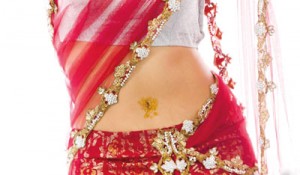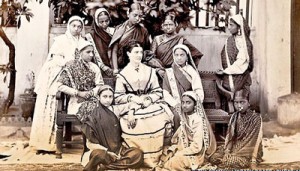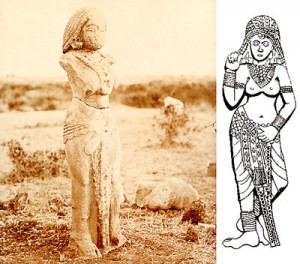Sunday Times 2
Dressing the Indian woman through history
View(s):This week in India a man slapped actress Gauhar Khan on a TV set for wearing a “short dress” and news emerged of outrage in a Mumbai law college at a strict dress code imposed on students. Fashion historian Toolika Gupta looks at ideas of decorum in fashion across India through the ages.

Even though it can be revealing, as the crop top leaves the midriff bare, the sari blouse has long been deemed decorous and associated with tradition
Every country has its own erogenous zones. What many Indians today believe are home-grown ideas of decorum and modesty are in fact British imports – bequeathed to us by the Raj.
The earliest representations of women show them with minimal clothing.
In sculptures from the Maury and Sunga periods (about 300 BC) – men and women wore rectangular pieces of fabric, on the lower part of the body and one on the upper part. Little else.
Images from the Gupta period – about the 7th or 8th Century – show stitched upper garments along with a breast band, as well as a lower garment.
Modesty has had different definitions over time and in different regions and communities. It was not always about covering your face and body and in many respects India’s hot climate led the way. People just did what was convenient.
But the regional variations are interesting. In southern India, even in colonial times, some women did not cover the upper part of their body. And throughout India’s history of contact with different cultures – with Greek, Roman, Arab and Chinese influences coming in – fashions and ideas began to change.

At the height of the Victorian era the British and Indian fashions rather resemble each other
In the 15th Century we see Muslim and Hindu women wearing different outfits and the influence of the Mughal empire was decisive – they ruled most of India and Pakistan in the 16th and 17th Centuries. I have not seen written codes about how to dress, but Muslim women normally covered themselves and wore divided garments. These outfits gave birth to garments like the salwar kameez – virtually seen as a national dress in India today.
In Bengal, in the Victorian era, some women did not wear blouses under their saris – they went bare-breasted. This did not suit Victorian society, which had its own ideas of propriety, and blouses increasingly became the norm.
It was Jnanadanandini Debi, the wife of Satyendranath Tagore – brother of the famous Bengali poet Rabindranath Tagore – who popularised the blouses, jackets and chemises and the modern style of the sari today after she was reportedly refused entry to clubs under the Raj for wearing the sari fabric over her bare breasts. Tagore is believed to have actively encouraged his wife to adopt Western ideas.
The terms “blouse” and “petticoat” – both English – made the leap into Indian vocabulary in the Victorian era. Shirts also came to be worn under the sari as part of high fashion and these rather British innovations are considered traditional garments.
Even though it can be revealing, as the crop top leaves the midriff bare, the sari blouse has long been deemed decorous and associated with tradition. In India it was important for a woman to cover her body with a draped fabric here no matter what is underneath.

Images from the Gupta period - about the 7th or 8th Century - show stitched upper garments along with a breast band, as well as a lower garment
The British influence only became stronger over time. We see different kinds of blouses coming in with sleeve structures, and various necklines.
In India, unlike in Britain, there are no written codes of conduct or sumptuary laws about what should be worn. What was considered suitable was spread through word of mouth.
So today’s guardians of the hemline – who no doubt believe they are safeguarding women by prescribing what women should wear – are following in the footsteps of older political overlords.
Indian women now are much freer to do what they want, at least in the cities, yet we see dress codes being set and women condemned for what they wear. Some people even make an association between clothing and rape.
These people don’t understand that ideas of decency are constantly changing and rape is not a consequence of what women wear but of how certain men think.
Our dress is our identity. But what we think of as traditional Indian modesty, can turn out not be not very Indian at all.
- Courtesy BBC

